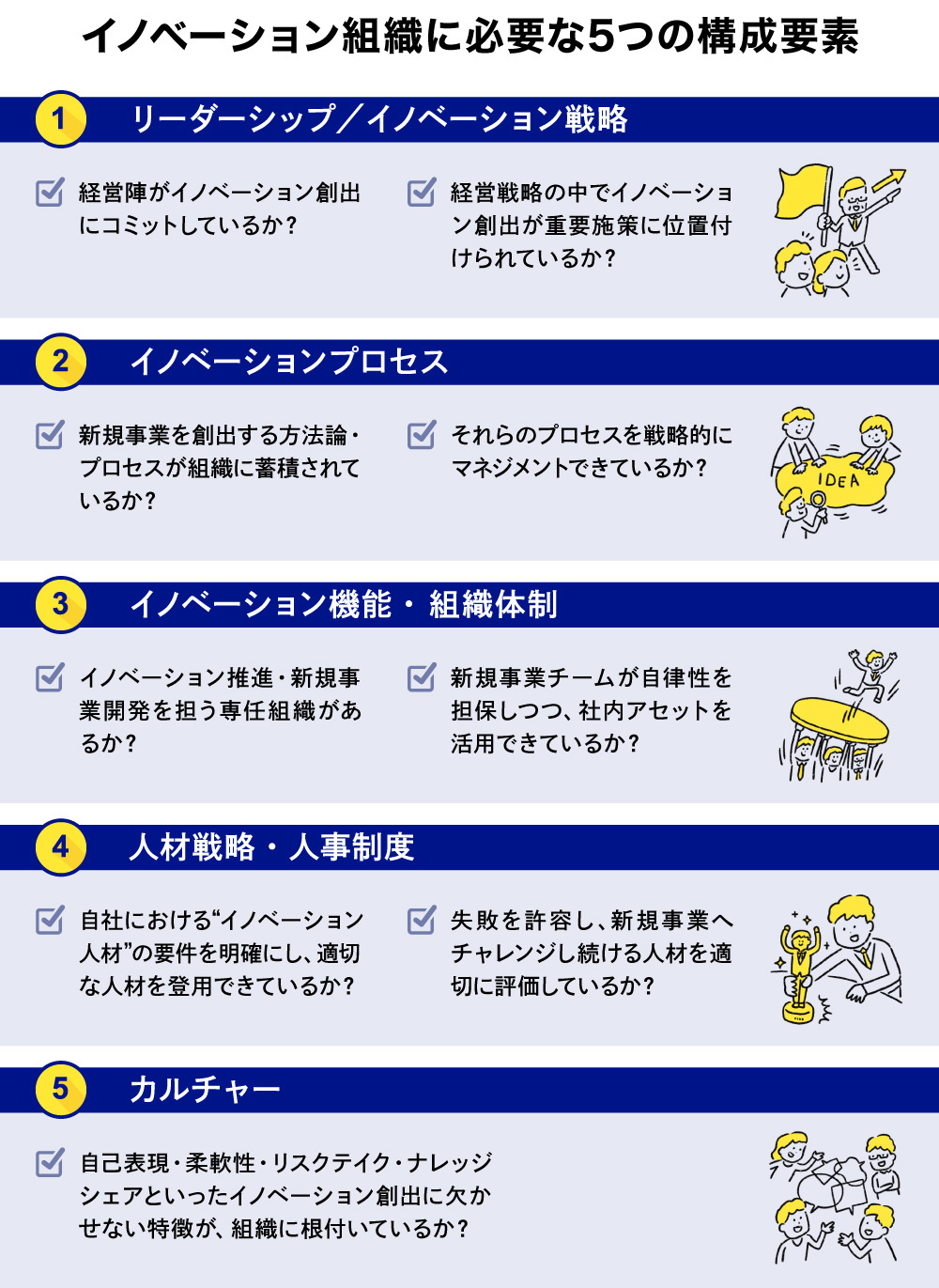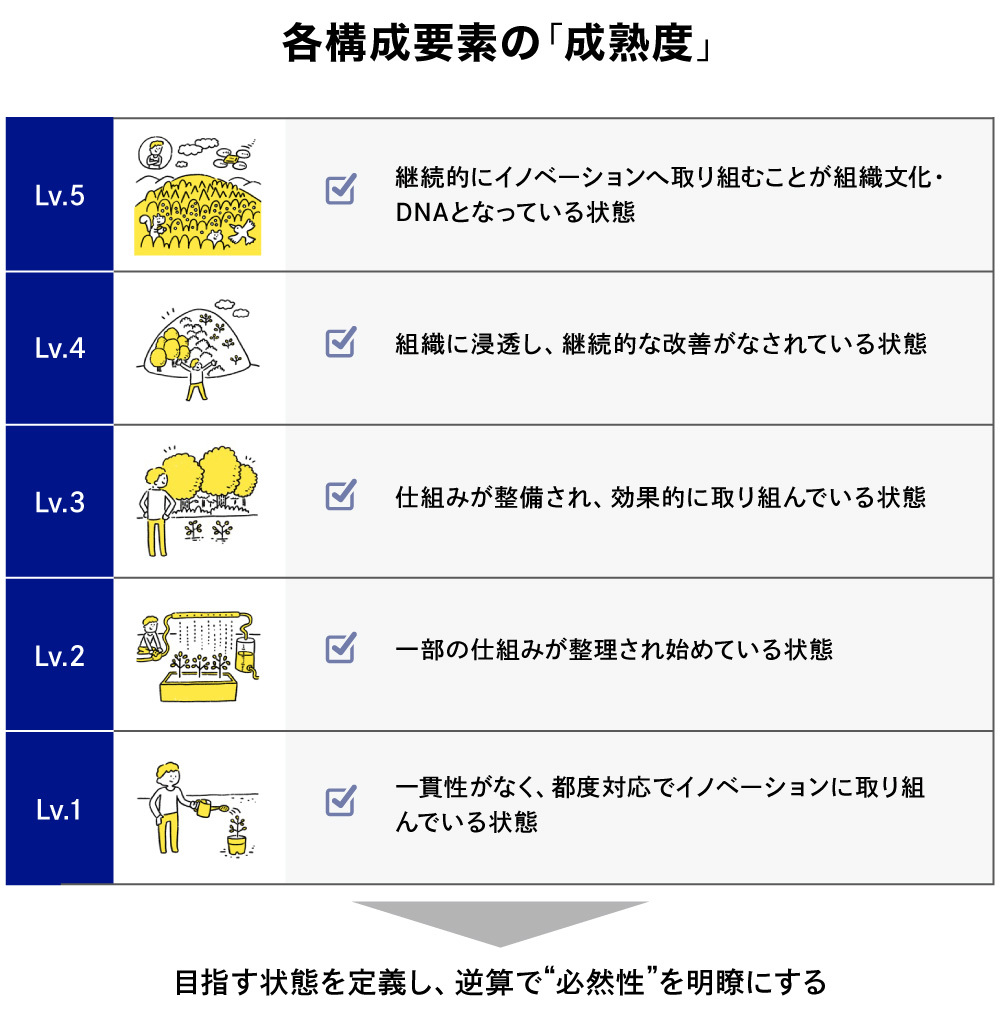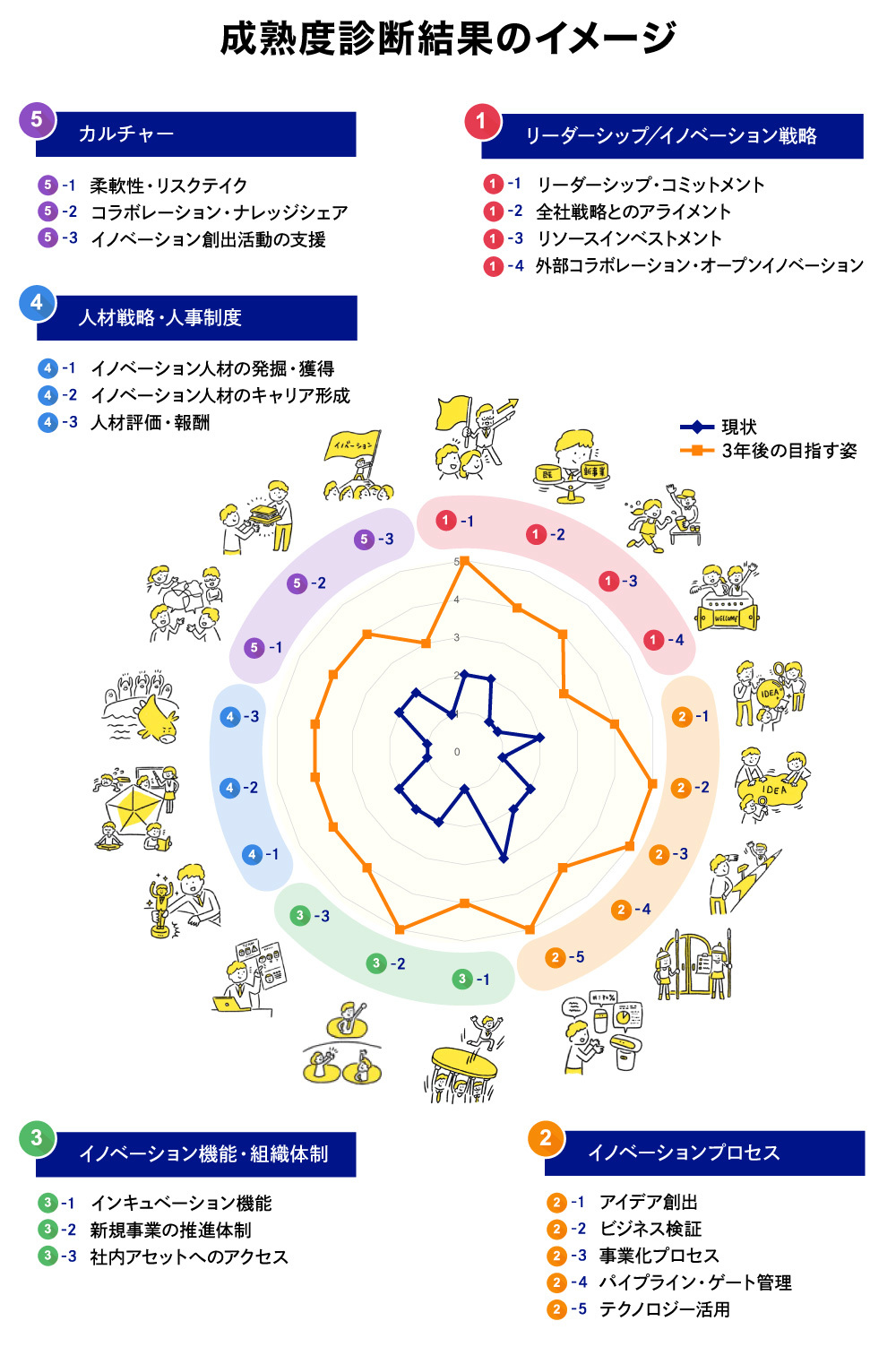Note: This website was automatically translated, so some terms or nuances may not be completely accurate.
What are the conditions for an organization that consistently generates innovation?
Innovation and new business creation are essential activities for companies to maintain competitive advantage. However, despite repeated efforts, do you ever find yourself stuck, unable to achieve results?
Upon analyzing such cases, the root problem often lies not in the individual business ideas themselves, but rather in the absence of an organizational foundation capable of generating new ventures.
How can you identify the elements lacking within your company and drive cross-departmental organizational transformation to sustainably generate innovation and new ventures?
This article explains concrete case studies and methodologies to provide practical insights for those concerned with driving innovation and new business initiatives, and the organizational transformation that supports them.
*For convenience, this article defines "new business" as activities that generate concrete new business ideas, translate them into business plans, and commercialize them. "Innovation" is defined more broadly to encompass all activities contributing to corporate value enhancement, including new business. When discussing both contextually, they are referred to collectively as "innovation and new business."
<Table of Contents>
▼Is the Root Cause of New Business Difficulty in "Organizational Structure"!?
▼The 5 Essential Components for Innovation-Driven Organizations
▼Transformation to an Innovation Organization Starts with "Shared Definition"
▼Two Examples of Innovation Organization Transformation Patterns
▼Summary of This Article
Is the Root Cause of Difficulty in Launching New Ventures in the "Organizational Structure"!?
When companies attempt to pursue new ventures internally, various issues often arise, hindering progress. For example:
- Many ideas emerge, but they fade away before reaching commercialization
- The significance of new ventures isn't understood within the company, making it hard to get cooperation from existing business units
- Employees feel participating in new ventures takes them off the traditional career path, leading to a lack of volunteers
Interestingly, these phenomena are common across industries and business types, particularly in reasonably mature companies. This fact suggests that the primary reason new ventures fail often lies in the "organizational structure" itself, rather than necessarily being a problem with the ideas themselves.
Methodologies for creating new ventures offer valuable insights from various angles, and large corporations with talented personnel should be able to implement them with high reproducibility. However, if these methodologies fail to function effectively even after superficial adoption, it suggests deeper-rooted "organizational characteristics" are hindering their practical application.
● Cases where the decision-making process within the company is problematic
Consider, for example, the decision-making process within a company. The authority for decision-making and the design of meeting structures vary greatly by company. Ultimately, however, within the structure of a large corporation, the vast majority of people are compelled to make decisions as "corporate employees." This means decisions tend to be those that are "easier to justify" or "based on examples from other companies or precedents."
Consequently, while companies may verbally "welcome failure," investment decisions for new ventures with uncertain outcomes often stall. Conversely, when results are not immediately visible, excessive blame is often assigned. This inadvertently creates a decision-making process that is inherently disadvantageous for generating new business.
● Cases where problems lie within corporate HR systems and operations
Consider another example: human resource management within companies, particularly in evaluation and promotion decisions. Human behavior within an organization is highly sensitive to how promotions actually occur—that is, how the personnel system is realistically applied—and adapts to these unspoken rules (or, those who don't adapt tend to leave).
It's common to see unconscious personnel practices prioritizing "existing business growth," where "larger sales figures or managing larger organizational units" are internally equated with being "important." When talented individuals building their careers within the company sense this practice will persist, they tend to avoid new ventures and refrain from volunteering.
These deep-rooted organizational traits have been unconsciously cultivated over a company's long history. While often invisible, they inevitably surface in critical moments.
Even when visible measures are introduced, such as holding internal business contests or launching new business divisions, the people running them are human. As they drive these initiatives forward, they become entangled in the existing organizational traits, and before they know it, momentum stalls.
That said, this article does not argue that new ventures within companies are inherently impossible. While high commitment from the new venture team is essential, it is entirely possible to improve success rates by simultaneously building systems and mechanisms that are aware of these organizational "quirks" and do not hinder the team's progress—but rather accelerate it.
To achieve this, it is first necessary to identify the components of the organization that require transformation ( ). We will explore this below.
Five Essential Organizational Components for Innovation Creation
Dentsu Consulting Inc. and Dentsu Inc. have continuously worked on launching new businesses and transforming organizations and talent.
Based on this experience, we have consolidated the elements companies must possess to continuously generate innovation into five domains and 18 items.

While the components themselves may not appear novel at first glance, precisely because they are not quick fixes, achieving full transformation requires perseverance and effort.
The key to transformation is "end-to-end integration." While departments within the company assigned specific missions work daily to fulfill their respective roles, cases where activities are coordinated across departments toward the common goal of innovation and new business creation are extremely rare.
Conversely, if you can identify where within these components the factors hindering your company's innovation creation lie, align understanding among stakeholders, and then execute transformation involving the responsible departments, the potential for achieving a breakthrough increases dramatically.
For example , "2. Innovation Process" and "3. Innovation Function/Organizational Structure" encompass methodologies for idea generation, hypothesis validation processes for commercialization, and gate management for investment decisions. These are often developed and structured by departments such as Corporate Planning, R&D, or the New Business Division.
However, when attempting to execute transformation following these processes,
- the company-wide approach to investment decisions conflicts with finance, hindering execution
- or the need for rapid hypothesis testing collides with delays in securing sales channel support or technical validation/prototyping assistance
Such issues arise.
What about "4. Talent Strategy & HR Systems"? While HR system methodologies evolve daily, the core principles have been thoroughly researched.
During my time at a consulting firm, I repeatedly designed systems alongside corporate HR departments. Speaking from personal experience, I must note that business strategy and HR strategy remain disconnected in many cases.
HR professionals who consistently collaborate with new business teams to develop necessary HR systems and initiatives demonstrate exceptionally high awareness.
Thus far, we have outlined the organizational components essential for innovation creation and the critical importance of driving these components seamlessly across departments.
In the next section, , we will explain specifically where and how to proceed to foster innovation.
The approach to transforming into an innovation organization begins with "shared definitions."
Based on my experience witnessing organizational transformations firsthand, I believe a major reason for stalled change is "low resolution in problem awareness."
I doubt anyone would disagree with the proposition that organizations should transform to become capable of generating innovation.
I doubt anyone would oppose the proposition of transforming into an organization capable of creating innovation. However, because each person has their own "interpretation" of what that means, specific objections arise, becoming a factor that hinders progress.
In other words, conversely,
defining the yardstick for "what" and "how much" to transform within the organization, sharing it among stakeholders, and increasing the resolution
is the driving force behind transformation.
At Dentsu Consulting Inc. and Dentsu Inc., we use five distinct descriptive levels to assess the maturity of each organizational component (5 domains, 18 items). This enables stakeholders to quantitatively align their understanding of the company's current state.


By defining the desired state and current state for each of the 18 items across five levels, the previously vague problem awareness of "innovation is difficult to generate" transforms as follows:
Example) A new business unit has been established and started activities, but it is floundering without momentum due to unclear significance, scale, and timeline for the new ventures. The positioning of new ventures within the company-wide strategy should be clearly articulated and concretely translated into the new business unit's mission.
(Leadership/Innovation Strategy Issue)
Example) The new business strategy is organized, but the company has not defined the requirements for innovator talent. They vaguely assign personnel with a good reputation in existing businesses, but it's not working well. They should identify aptitude and strategically assign personnel.
(Human Resources Strategy/HR System Issue)
Thus, it is crucial to pinpoint the root of the problem and translate vague concerns into tangible, actionable activities.
 [Figure 4] Enhance maturity across all 18 items in the 5 domains. The inner blue line represents the current state; the outer orange line shows the target state in 3 years.
[Figure 4] Enhance maturity across all 18 items in the 5 domains. The inner blue line represents the current state; the outer orange line shows the target state in 3 years.A common pitfall is implementing measures that create a visible "sense of activity" without first clearly defining the fundamental significance of pursuing innovation and new ventures, or the desired state of the organization needed to achieve them. Examples include holding business contests or launching innovation workshops using external instructors.
While these certainly yield better results than doing nothing, accumulating such awareness-raising or literacy-enhancement level initiatives makes it difficult to achieve fundamental transformation. Often, these become one-off measures that eventually fizzle out.
The first task for the secretariat of a new business project should be the groundwork activities described above: carefully setting goals and articulating them, even if it takes time, and involving relevant departments at the executive level.
Two Examples of Transformation Patterns for Innovation Organizations
Finally, I'd like to introduce cases where the challenges outlined above have been clarified, hoping to give you a sense of how transformation can be driven forward.
●Example 1: Cases Where Leadership/Innovation Strategy is the Problem
Surprisingly common is the case where the executive leadership that issued the call for innovation or new ventures lacks sufficient clarity themselves, or has not sufficiently aligned with the operational layer. Some executives deliberately leave room for interpretation and concretization at the operational level, presenting only high-level policies.
This results in a situation where a new business division is established and given the mission "to execute," but no further concrete direction is provided.
When conducting an organizational diagnosis in such cases, the "Leadership/Innovation Strategy" score often reveals stark results: while the diagnosis for the executive level is not bad, the diagnosis for the operational staff members is low.
Management may believe they have clearly articulated high-level direction and instead feel frustrated that things aren't moving forward. Meanwhile, the operational layer may feel immobilized, unable to progress with budgeting or consensus-building without concrete company-wide direction.
In this case, demanding self-transformation from the executive level or expecting concrete top-down policies is not necessarily the best approach.
A more effective approach is for capable department heads and section managers to develop concrete strategies for new ventures. They should then align these strategies with the company's mission, vision, and values, secure executive approval, and build upon this foundation to advance concrete activities.
●Example 2: Cases where talent strategy/HR systems are problematic
Few companies have fully integrated their HR systems to facilitate new business creation, making this a frequently underperforming area.
The first step is to define the profile of innovator talent within your company. A key caution here is to avoid defining this profile in general terms.
While a quick search will yield numerous elements for innovator talent requirements, this approach is largely meaningless. The necessary actions vary depending on factors like whether the company is launching new ventures in adjacent areas to existing businesses or tackling entirely new, uncharted territories.
Furthermore, the requirements for a successful team differ from company to company, not only based on the business domain but also on values and leadership style.
First, clearly define what kind of business will be launched and under what dynamics. Then, while fully understanding the new business strategy, define the ideal candidate profile. Next, design consistently how to acquire/develop such talent, how to form teams that generate positive chemistry, and what compensation systems and staffing practices are needed to achieve this.
Summary of this article
- Organizational issues are a major reason innovation and new business creation stall
- Organizations must possess specific elements (5 domains, 18 items) to sustainably generate innovation and new ventures
- Implementing these elements inevitably requires cross-departmental activities
- Rather than jumping at easily understandable measures, carefully defining the significance of innovation and new ventures, along with the desired state required to achieve them, is actually the most efficient path.
It's easier said than done, but we believe that persistently confronting the necessity of such organizational transformation and tenaciously pursuing it is an essential attitude that cannot be avoided to achieve breakthroughs.
We hope this provides some insight into innovation and new business activities.
Dentsu Consulting Inc.
https://www.dentsuconsulting.com/
Was this article helpful?
Newsletter registration is here
We select and publish important news every day
For inquiries about this article
Back Numbers
Author

Fukushima Kei
Dentsu Consulting Inc.
Principal
After working at a major consulting firm, he assumed his current position. His areas of expertise include establishing frameworks and providing ongoing support for new business launches and business transformations; formulating and executing organizational strategies; enhancing talent strategies and HR functions to realize management strategies; and supporting human capital management. At Dentsu Consulting Inc., he led integrated design and execution support ensuring business strategy and organizational/talent strategy remained aligned.



